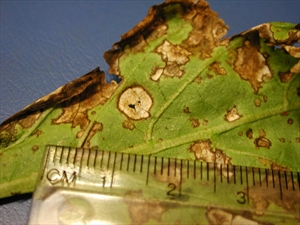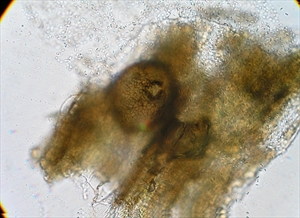Capsicum blight
Pacific Pests, Pathogens, Weeds & Pesticides - Online edition
Pacific Pests, Pathogens, Weeds & Pesticides
Capsicum Phoma blight (239)
Phoma species; commonly Phoma exigua. It was previously known as Ascochyta phaseolorum. It has been renamed Boeremia exigua var. exigua.
Distribution uncertain because of taxonomic changes. Boeremia exigua var. exigua is recorded from Australia. Phoma exigua is recorded in Papua New Guinea on several legumes, but not on capsicum or tomato; it is recorded causing a fruit rot on capsicum in Cook Islands and Tonga, and on leaves of tomatoes in Fiji.
Capsicum, and many other crop plants are hosts, e.g. cotton, cowpea, eggplant, okra, soybean, and tomato. Beans (and other legumes) are a common host. In Tonga, the fungus has been recorded on capsicum, and in Fiji it is a problem on tomato, and also on Rutaceae, the citrus family. Weeds are hosts of the fungus.
Irregular to round, small, 1-2 mm, brown spots occur on the leaves, becoming pale brown to grey with a brown border as they mature (Photos 1&2). Stems are also infected. Large spots occur on the fruit (Photo 3). Tiny black fruiting bodies known as 'pycnidia' occur in the pale brown leaf spots; these can be seen with the naked eye. The fruiting bodies on the fruits discharge masses of spores as the spots grow and age; the spots have a ringed appearance (Photo 3). The spores are discharged through a hole at the top of the fruiting body (Photo 4).
The fungus is thought to be a common wound pathogen following damage to the leaf and fruit by weather or insects. It is commonly found in the soil. Spread of the fungus occurs in wet weather which helps the discharge of spores. As the spores ooze out of the fruiting bodies they are then splashed in rain (or irrigation water). There is a possibility that the spores of the fungus can be carried on seed. The fungus survives on dead plant material.
Phoma exigua is considered to be a weak parasite or a wound pathogen and does not cause an important disease; infection needs plants to be damaged by weather or by insects. On capsicum, it is probably similar to Phoma rot on tomato where it is usually only a problem in very wet seasons.
Look for small irregular spots on the leaves, brown at first, drying out with black fruiting bodies later. Look for fruits with large spreading spots forming concentric circles, also with black fruiting bodies.
As the fungus is thought to be a wound pathogen, it is unlikely that control measures will be needed against this disease. If they are needed, do the following:
CULTURAL CONTROL
During growth:
- Be careful not to damage plants during cultural operations.
- Remove weeds which may be a source of the fungus.
- If fruit flies are thought to be the cause of damage, see the fact sheets on fruit flies for specific control measures.
After harvest:
- Handle fruit carefully during harvest and packing to avoid injury.
- As soon as the crop has been harvested remove or destroy the remains.
- Rotate crops so that crops of capsicum do not follow each other on the same land.
CHEMICAL CONTROL
This is not recommended as the fungus is thought be a wound pathogen. If required, use chlorothalonil, copper or mancozeb.
____________________
When using a pesticide, always wear protective clothing and follow the instructions on the product label, such as dosage, timing of application, and pre-harvest interval. Recommendations will vary with the crop and system of cultivation. Expert advice on the most appropriate pesticides to use should always be sought from local agricultural authorities.
AUTHOR Grahame Jackson
Information from McKenzie E (2013) Boeremia exigua: PaDIL - https://www.padil.gov.au/; and from CABI (2019) Boeremia exigua var. exigua (leaf spot). Crop Protection Compendium. (https://www.cabi.org/cpc/datasheet/40426). Photos 1&2 Jacqui (Wright) Kami, formerly Plant Pathologist, Secretariat of the Pacific Community, Suva, Fiji. Photo 3 Phoma pycnidia Bruce Watt, University of Maine, Bugwood.org. Photo 4 Phoma sp. Division of Plant Industry Archive, Florida Department of Agriculture and Consumer Services, Bugwood.org.
Produced with support from the Australian Centre for International Agricultural Research under project PC/2010/090: Strengthening integrated crop management research in the Pacific Islands in support of sustainable intensification of high-value crop production, implemented by the University of Queensland and the Secretariat of the Pacific Community.







